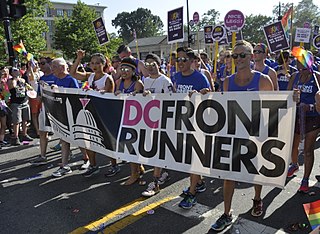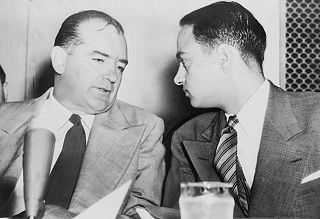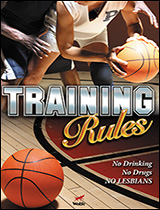
Cherry Grove is a hamlet in the Town of Brookhaven, Suffolk County, New York, United States. It is located on Fire Island, a barrier island separated from the southern side of Long Island by the Great South Bay. The hamlet has approximately 300 houses on 41 acres (17 ha), a summer seasonal population of 2,000 and a year-round population of 15.
Diane DiMassa is an American feminist artist, noted as creator of the alternative cartoon character Hothead Paisan, Homicidal Lesbian Terrorist, whose wild antics have been described as rage therapy for the marginalised. DiMassa is also active in oil painting and street art.

Fire Island is the large center island of the outer barrier islands parallel to the South Shore of Long Island in the U.S. state of New York.

Race walking, or racewalking, is a long-distance discipline within the sport of athletics. Although a foot race, it is different from running in that one foot must appear to be in contact with the ground at all times. Race judges carefully assess that this is maintained throughout the race. Typically held on either roads or running tracks, common distances range from 3,000 metres (1.9 mi) up to 100 kilometres (62.1 mi).

Fire Island Pines is a hamlet in the Town of Brookhaven, Suffolk County, New York, United States. It is located on Fire Island, a barrier island separated from the southern side of Long Island by the Great South Bay.
Patricia Nell Warren, also known by her pen name Patricia Kilina, was an American novelist, poet, editor and journalist. Her second novel, The Front Runner (1974), was the first work of contemporary gay fiction to make the New York Times Best Seller list. Her third novel, The Fancy Dancer (1976), was the first bestseller to portray a gay priest and to explore gay life in a small town.
Karla Jay is a distinguished professor emerita at Pace University, where she taught English and directed the women's and gender studies program between 1974 and 2009. A pioneer in the field of lesbian and gay studies, she is widely published.
Lavender Menace was an informal group of lesbian radical feminists formed to protest the exclusion of lesbians and their issues from the feminist movement at the Second Congress to Unite Women in New York City on May 1, 1970. Members included Karla Jay, Martha Shelley, Rita Mae Brown, Lois Hart, Barbara Love, Ellen Shumsky, Artemis March, Cynthia Funk, Linda Rhodes, Arlene Kushner, Ellen Broidy, and Michela Griffo, and were mostly members of the Gay Liberation Front (GLF) and the National Organization for Women (NOW). They later became the Radicalesbians.
Front-runner is a term to describe the leader in a race, whether in politics, sports or a beauty pageant.

International Front Runners (Frontrunners) is an umbrella organization of LGBTQ running and walking clubs around the world. The walking clubs are called Frontwalkers.

LGBTQ+ Victory Fund, commonly shortened to Victory Fund, is an American political action committee dedicated to increasing the number of out LGBTQ+ public officials in the United States. Victory Fund is the largest LGBTQ+ political action committee in the United States and one of the nation's largest non-connected PACs.

The Lavender Scare was a moral panic about homosexual people in the United States government which led to their mass dismissal from government service during the mid-20th century. It contributed to and paralleled the anti-communist campaign which is known as McCarthyism and the Second Red Scare. Gay men and lesbians were said to be national security risks and communist sympathizers, which led to the call to remove them from state employment. It was thought that due to the stigma around homosexuality, gay people were vulnerable to blackmail, which could lead to a breach in national security. Lesbians were at less risk of persecution than gay men, but some lesbians were interrogated or lost their jobs.

Catherine Hardy Lavender was an American athlete who competed mainly in the 100-meter dash. She won an Olympic gold medal in the 4 × 100 metres relay at the 1952 Olympic Summer Games in Helsinki, Finland. Later, Hardy married, had children, and a 30-year teaching career in Atlanta schools.

Gay's the Word is an independent bookshop in central London, and the oldest LGBT bookshop in the United Kingdom. Inspired by the emergence and growth of lesbian and gay bookstores in the United States, a small group of people from Gay Icebreakers, a gay socialist group, founded the store in 1979. These included Peter Dorey, Ernest Hole and Jonathan Cutbill. Various locations were looked at, including Covent Garden, which was then being regenerated, before they decided to open the store in Marchmont Street in Bloomsbury, an area of the capital with rich academic and literary associations. Initial reluctance from Camden Council to grant a lease was overcome with help from Ken Livingstone, then a local councillor, later Mayor of London. For a period of time, it was the only LGBT bookshop in England.
"Katie and Emily" is the ninth and penultimate episode of the third series of the British teen drama Skins, which first aired on 19 March 2009 on E4 in both Ireland and the United Kingdom. The episode was written by Malcolm Campbell and Bryan Elsley, and was directed by Charles Martin. The episode focuses on the characters of twins Katie and Emily Fitch as they prepare for their college's annual ball. Katie refuses to leave home, recovering from being hit in the head with a rock, and faces her weakening control over her sister. Emily, meanwhile, is heartbroken when her girlfriend, Naomi Campbell, turns down Emily's invitation to the ball, and comes out to her family about her sexuality.

Training Rules is a 2009 American documentary co-produced and co-directed by Dee Mosbacher and Fawn Yacker. It is narrated by Diana Nyad.
The lesbian, gay, bisexual, transgender, queer, and other non-heterosexual or non-cisgender (LGBTQ+) community is prevalent within sports across the world.

Martha Shelley is an American activist, writer, and poet best known for her involvement in lesbian feminist activism.
A Different Light was a chain of four LGBT bookstores in the United States, active from 1979 to 2011.
Margaret Ann "Peg" Grey was an American physical education teacher and sports organizer based in Chicago. She was the first female co-chair of the Federation of Gay Games. She was inducted into the Chicago LGBT Hall of Fame in 1992.











